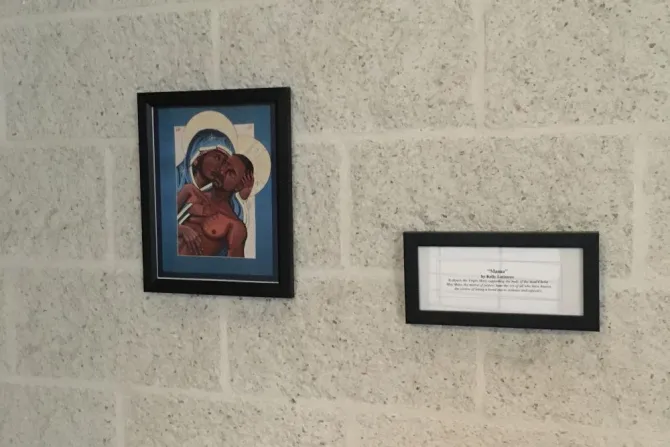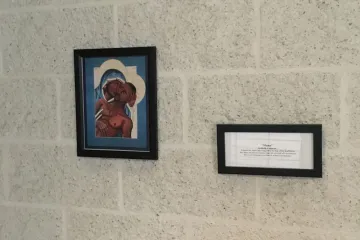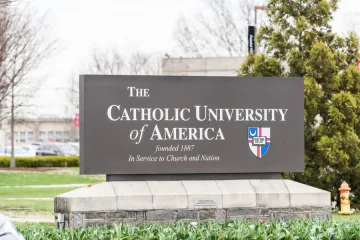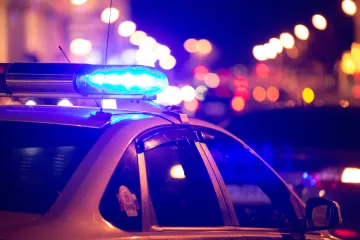Denver Newsroom, Dec 9, 2021 / 11:28 am
An image portraying the Virgin Mary and Jesus as Black in a way that some critics said politicized religion to comment on the murder of George Floyd was defended and replaced by Catholic University of America officials after it was stolen in late November. The university’s student government, however, has now passed a resolution calling for the image to be replaced with other art that better fulfills the needs for theological art and representation of the Black community.
“There are other paintings and icons that do a much better job at making a genuine, good faith effort to reflect the universality of the Catholic Church that also do not divide and confuse the university and larger Catholic community,” said the resolution, passed by the student government senate, in a 15-9 vote on Dec. 6.
The resolution’s title said it aimed to “unify the community by replacing controversial icons.” The text asks for the university to remove the paintings from university buildings and to work to replace them with “other forms of art that represent diversity and bring forth representation of the African American community in a non-political and uncontroversial way.”
CNA contacted the university for comment but did not receive a response by deadline.
The painting, by the St. Louis-based artist Kelly Latimore, is titled “Mama.” It was installed in February outside the chapel at the university's Columbus School of Law. In a style reminiscent of Eastern Christian iconography, the artwork portrays a Black Virgin Mary and Jesus in a Pieta-like scene. Mary’s gaze looks outward towards the viewer.
The image was stolen the night of Nov. 23. University officials replaced it with an identical, smaller copy from the campus ministry office.
University officials have said they always saw the image as representing Jesus. Latimore has said the painting was commissioned to “mourn” George Floyd, a Black man killed in police custody in May 2020.
When asked if the figure in the pieta is George Floyd or Jesus, he responded ambiguously, answering “yes.”
Floyd’s death sparked nationwide protests, some of which turned violent. Former Minneapolis police officer Derek Chauvin, who kneeled on Floyd’s neck for more than 9 minutes, was later convicted on three charges of unintentional second-degree murder, third-degree murder, and second-degree manslaughter. He was sentenced to more than 22 years in prison.
The university addressed the image after it was stolen.
“There are those who would like to see George Floyd as the male figure in the icon. That is not how we read it,” the university said. “The image represents to our community a good-faith attempt to include religious imagery on campus that reflects the universality of the Catholic Church.”
“We hope to continue to build on campus a culture that engages in thoughtful dialogue and debate, not the sort of bully tactics epitomized by this theft,” Catholic University of America president Marcus Garvey said Nov. 24.
He acknowledged that some critics saw the image as blasphemous “because they saw it as deifying or canonizing George Floyd.”
“Some comments that we received were thoughtful and reasonable. Some were offensive and racist. Much of the criticism came from people unconnected to the university,” Garvey said.
The student government resolution cited some objections to the image.
(Story continues below)
“This icon is seen as blasphemous, offensive, and at the very least confusing not only to students but many in the general public and only serves to further divide the community,” it said.
“The purpose of sacred art is not to make a political statement but to promote worship, adoration, and faith ‘in the transcendent mystery of God’,” said the resolution, citing the Catechism of the Catholic Church.
The resolution said theological artworks on campus have “few representations of the African American community” and that the university could “increase and amplify those voices in a way that is consistent with the university’s mission.”
Latimore, the artist, told the Christian Century in an April 2021 interview that his “non-answer” about whether the image was about George Floyd or Jesus was frustrating to many people and he thought the fact it is a question is “part of the problem.”
“Again, it’s them trying to protect God, and we can be pretty sure that when we try to protect God, we’re creating an idol.”
The initial sketch of ‘Mama’ showed Mary looking at the figure of Jesus. Later versions shifted her gaze to the viewer, a change Latimore said was “powerful.”
“It wasn’t focusing on the death, which was horrible, but the viewer, and guiding us to communal thought and prayer and action.”






